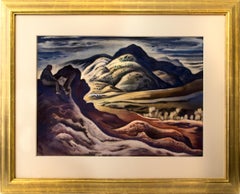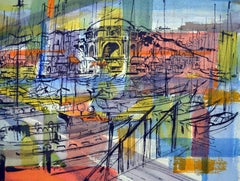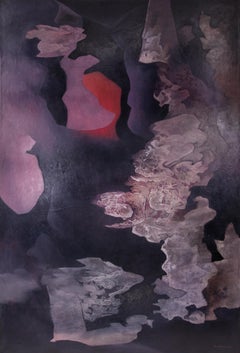Vance Kirkland Paintings
As an artist and educator, Vance Kirkland almost single-handedly brought modern art to Denver. At a time when conservative tastes ruled, he came to Colorado and worked in a manner that emphasized process more than subject matter. Rather than pleasing landscapes, he created paintings that expressed the dynamic forces of the universe, often with results that were strange and otherworldly. Standing on principle, he never wavered from his conviction that the arts were respected disciplines and he constantly pushed for the inclusion of modern art in Denver’s public institutions. Deliberately working away from the major art centers, Kirkland’s varied art styles were determined by his compass yet were nationally recognized. Growing up in Ohio, Kirkland began his art studies at the Cleveland School of Art, where he received a diploma in painting and a bachelor’s degree in art education. The former curator of the Denver Art Museum, Diane Vanderlip points to a failed watercolor class as an indicator of both his future stylistic development and his early self-confidence. When the teacher criticized Kirkland for colors that fought with each other, the young man listened to his muse rather than pass the course. Upon graduation, he was offered a job at Princeton, but when the university discovered just how young he was, they withdrew their offer. He then accepted an offer at the University of Denver to establish their art department in 1929. While most schools shunted art offer to the side, Kirkland developed the program as a combination of academics and art. He also got officials to accept nude figure drawing. However, a parting of the ways came when he and the Provost clashed over degree recognition. The subsequent establishment of his Kirkland School of Art became a cultural beacon in this Rocky Mountain capitol. From 1927–44, he worked in a style he referred to as “Designed Realism,” in which natural forms were highly stylized in rhythmic shapes. Working totally in watercolor, he developed an individualized method of applying dots to a saturated color surface. By the end of the 30s, Kirkland’s paintings became larger and more energetic. Hiking in the mountains, the artist was inspired by the unusual shapes of high-altitude plants and trees stunted and bent by the fierce winds. Taking his painting gear, he had to add antifreeze to his paints to work in these demanding conditions. Departing from his ordinary perspective, Kirkland created compositions of open spaces and wild linear elements, which he increasingly liberated from any specific representation. In his fantastic imaginings, he had an affinity with Surrealism, although he had no interest in their Freudian pursuits. Kirkland received national attention with inclusion in exhibitions, such as “Abstract and Surrealist American Art” at the Art Institute of Chicago and “Reality and Fantasy” at the Walker Art Center. In 1946, Knoedler and Company in New York invited him to be one of their artists, which brought solo shows and group exhibitions with artists like Max Ernst. Beginning in the 1940s, he also became more active with the Denver Art Museum, serving in various honorary and formal positions. Both in his capacity as board member and curator, he relentlessly pressed for the recognition of contemporary art and artists. At the same time, his prestige grew when the University of Denver invited him back: this time as Director of the School of Art, Professor of Painting, and Chairman of the Department of Arts and Humanities. In 1941, he married Anne Fox Oliphant Olson, a librarian, and their home was a center for Denver’s cultural life with evening salons and musical performances. His first non-objective painting, Red Abstraction (1951) initiated his break with his past art. Looking back, Kirkland said, “There had to be a way of creating something and I became interested in abstraction.” Deciding to forego watercolor, he experimented with paint and materials, particularly with inventive ways of mixing them. He had always been intrigued by the quality of resistance, and now he used the combination of oil and water to cause unexpected effects. The surface of his canvases became almost like breathing skins. Committed to his new direction, Kirkland didn’t flinch when Knoedler’s dropped him for abandoning his commercially successful style. Moving to greater heights, Kirkland began painting large canvases that suggested cosmic phenomena, some of which he called “nebula.” Although the 50s saw the birth of space exploration, the artist deliberately avoided any astronomical study, preferring instead to paint the mystery beyond his knowledge. When he saw pre-Hubble photographs that looked startlingly similar, he decided to stop. Towards the end of his career, he returned to his earlier practice of layering the surface with dots. The works that first appeared in 1963 were geometric abstractions that share some of the qualities of contemporary Op Art. These later paintings were painstakingly done. Always a tireless worker, he pursued his art even after hepatitis made painting more difficult and physically excruciating, devising a system that suspended him over his canvases.
1940s American Modern Vance Kirkland Paintings
Watercolor
1930s American Modern Vance Kirkland Paintings
Watercolor, Rag Paper
1950s American Modern Vance Kirkland Paintings
Paper, Watercolor
Mid-20th Century American Modern Vance Kirkland Paintings
Paper, Gouache, Oil Pastel
Mid-20th Century American Modern Vance Kirkland Paintings
Paper, Gouache
20th Century American Modern Vance Kirkland Paintings
Oil, Gouache, Archival Paper
Mid-20th Century American Modern Vance Kirkland Paintings
Paper, Gouache
1970s American Modern Vance Kirkland Paintings
Oil
21st Century and Contemporary American Modern Vance Kirkland Paintings
Resin, Mixed Media, Acrylic, Wood Panel
2010s American Modern Vance Kirkland Paintings
Gesso, Oil, Acrylic, Wood Panel
Early 2000s American Modern Vance Kirkland Paintings
Oil, Board
Mid-20th Century American Modern Vance Kirkland Paintings
Paper, Gouache
Mid-20th Century American Modern Vance Kirkland Paintings
Oil, Panel
Mid-20th Century Abstract Expressionist Vance Kirkland Paintings
Canvas, Oil
Mid-20th Century Abstract Vance Kirkland Paintings
Oil
1930s American Modern Vance Kirkland Paintings
Watercolor
Mid-20th Century Surrealist Vance Kirkland Paintings
Watercolor
20th Century Abstract Vance Kirkland Paintings
Canvas, Oil
Mid-20th Century Abstract Expressionist Vance Kirkland Paintings
Oil, Canvas
1940s American Modern Vance Kirkland Paintings
Watercolor
20th Century American Modern Vance Kirkland Paintings
Watercolor
Mid-20th Century Abstract Vance Kirkland Paintings
Oil
1920s American Modern Vance Kirkland Paintings
Watercolor
20th Century Abstract Expressionist Vance Kirkland Paintings
Oil
1940s American Modern Vance Kirkland Paintings
Oil




